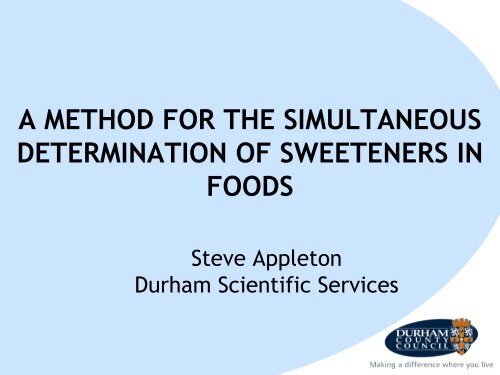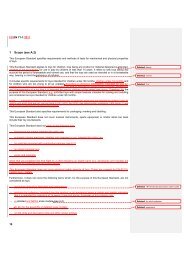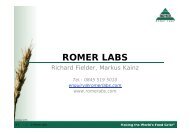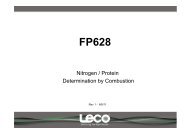Artificial Sweeteners Analysis
Artificial Sweeteners Analysis
Artificial Sweeteners Analysis
You also want an ePaper? Increase the reach of your titles
YUMPU automatically turns print PDFs into web optimized ePapers that Google loves.
A METHOD FOR THE SIMULTANEOUS<br />
DETERMINATION OF SWEETENERS IN<br />
FOODS<br />
Steve Appleton<br />
Durham Scientific Services
FOOD STANDARDS AGENCY<br />
Proposal: Develop a fully validated<br />
method for the simultaneous<br />
determination of sweeteners in<br />
foods
Permitted sweeteners<br />
<strong>Sweeteners</strong> in Food Regulations 1995<br />
• Acesulfame K (E950) ~ 25-2000ppm<br />
• Aspartame (E951) ~ 25-6000ppm<br />
• Saccharin (E954) ~ 80-3000ppm<br />
• Sucralose (E955) ~ 10-3000ppm<br />
• Neohesperidine dihydrochalcone (NHDC)<br />
(E959) ~ 10-400ppm
Permitted sweeteners<br />
<strong>Sweeteners</strong> in Food Regulations 1995<br />
• Cyclamate (E952)<br />
• Thaumatin (E957)<br />
• Aspartame-Acesulfame salt (E962)
Methodology<br />
<strong>Sweeteners</strong> are a group of chemically unrelated<br />
compounds.<br />
• High Performance Liquid Chromatography<br />
• UV detection is suitable for compounds<br />
possessng a chromophore such as acesulfame<br />
K, saccharin, aspartame and NHDC.<br />
• Refractive index detection is suitable for<br />
sucralose.<br />
• Cyclamate can be derivatised to make it UV<br />
active or can undergo postcolumn reaction with<br />
fluorescence detection.
Other methods<br />
Methodology<br />
• Ion chromatography with pulsed<br />
amperometric detection<br />
• Capillary electrophoresis<br />
• Enzymatic<br />
• Ion selective electrode<br />
• Spectrophotometry<br />
• Flow injection analysis
Methodology<br />
• The European Organisation for<br />
Standardisation (CEN) has published six<br />
validated methods with respect to intense<br />
sweetener determination.<br />
• Standard method BS EN 12856, Foodstuffs<br />
– Determination of acesulfame K,<br />
aspartame and saccharin – High<br />
performance liquid chromatographic<br />
method.
Methodology<br />
Sample preparation<br />
• Extraction into water, aqueous solutions or<br />
organic solvents.<br />
• Clean samples can be analysed directly or filtered<br />
before analysis.<br />
• More complicated matrices:<br />
• clarified using Carrez solutions to precipitate<br />
proteins and fatty acids.<br />
• use of solid phase extraction (SPE), typically<br />
C18 since colourings, flavourings and fat cannot<br />
be separated by Carrez clarification.
Evaporative Light Scattering<br />
Detector (ELSD)<br />
Gaining popularity as a universal detector.<br />
Simple three step process<br />
• Nebulisation – column effluent forms a dispersion<br />
of droplets<br />
• Evaporation – mobile phase is evaporated, leaving<br />
a fine mist of dried sample.<br />
• Detection – laser light scattered by sample particles<br />
is detected, generating an electrical signal.
Pro<br />
Evaporative Light Scattering<br />
Detector (ELSD)<br />
• since all particles scatter light, all sample<br />
components are detected, regardless of their<br />
structure or optical properties.<br />
Con<br />
• method limitations as it can only be used with<br />
volatile mobile phases and mobile phase<br />
modifiers
ELSD
ELSD plus UV
Food matrices examined<br />
• Yogurt – natural, low fat<br />
Development<br />
• Jam – raspberry, seedless<br />
• Mayonnaise<br />
• Chocolate cake<br />
• Cola drink<br />
• Samples spiked with sucralose, acesulfame K,<br />
saccharin, aspartame and NHDC, each at 100ppm.
Variables<br />
Development<br />
• Extraction solvent<br />
Variation of water: IDA ratio<br />
Too much IDA gives poor peak shape<br />
Too little IDA gives poor recoveries for<br />
NHDC and aspartame<br />
Optimum 75:25 (by volume) water: IDA
Development<br />
• Clarification using Carrez reagents<br />
• pH<br />
Use has little effect on chromatography.<br />
Use gives much lower NHDC recoveries.<br />
Little variation in recoveries over the<br />
range 3-8 except for aspartame.<br />
Aspartame most stable at pH 4, at pH 7<br />
decomposition is rapid.
Working Method<br />
Extraction<br />
Liquid samples<br />
• Measure 50mL of sample into a 100mL<br />
volumetric flask and add 20mL of IDA. Make up<br />
to volume with water and mix well.<br />
Solid samples<br />
• Weigh 20g of sample into a jar. Add 80mL of<br />
75:25 water: IDA and mix well by hand. Place the<br />
jar on a mechanical shaker and shake vigorously<br />
for 30 minutes.
Working Method<br />
Solid samples (continued)<br />
• Transfer the solution to a centrifuge tube and<br />
centrifuge at 3000 rpm for 15 minutes. Filter the<br />
supernatant liquid through a Whatman GF/A filter<br />
paper or similar. Take a portion of the filtrate and<br />
pass through a syringe filter into a 2mL glass vial<br />
ready for HPLC analysis.
Working Method<br />
HPLC with UV Diode Array Detection<br />
Acesulfame K, Saccharin, Aspartame, NHDC<br />
Column : ACE 5 C18 250 x 4 mm 5µm<br />
Guard column : ACE 5 C18 10 x 4 mm 5µm<br />
Column temperature : 30°C,<br />
Flow :<br />
1.0 mL/min<br />
Stop time : 40 mins<br />
Solvent : Time (min) 0 25 30 35<br />
A : Water 88% 50% 30% 88%<br />
B : Acetonitrile 2% 40% 60% 2%<br />
C : Methanol 0% 0% 0% 0%<br />
D :1% TFA 10% 10% 10% 10%<br />
Injection volume : 5µL<br />
Detector : Acesulfame K 231nm, Saccharin 231nm, Aspartame 215nm,<br />
NHDC 280nm.
Working Method<br />
HPLC with Refractive Index Detection<br />
Sucralose<br />
Column : Hypersil ODS 250 x 4 mm 5µm<br />
Guard column : Hypersil ODS 4 x 4 mm 5µm<br />
Column temperature : 30°C<br />
Flow :<br />
1.5 mL/min<br />
Stop time :<br />
15 mins<br />
Solvent :<br />
Premixed 20:80 methanol:water<br />
Injection volume : 100µL
Mean % Recoveries<br />
Yogurt Jam Mayo Cake Cola<br />
Sucralose 95 108 108 86 101<br />
Ace K 93 108 110 108 105<br />
Saccharin 86 107 109 88 105<br />
Aspartame 90 125 113 55 104<br />
NHDC 72 108 109 75 107








